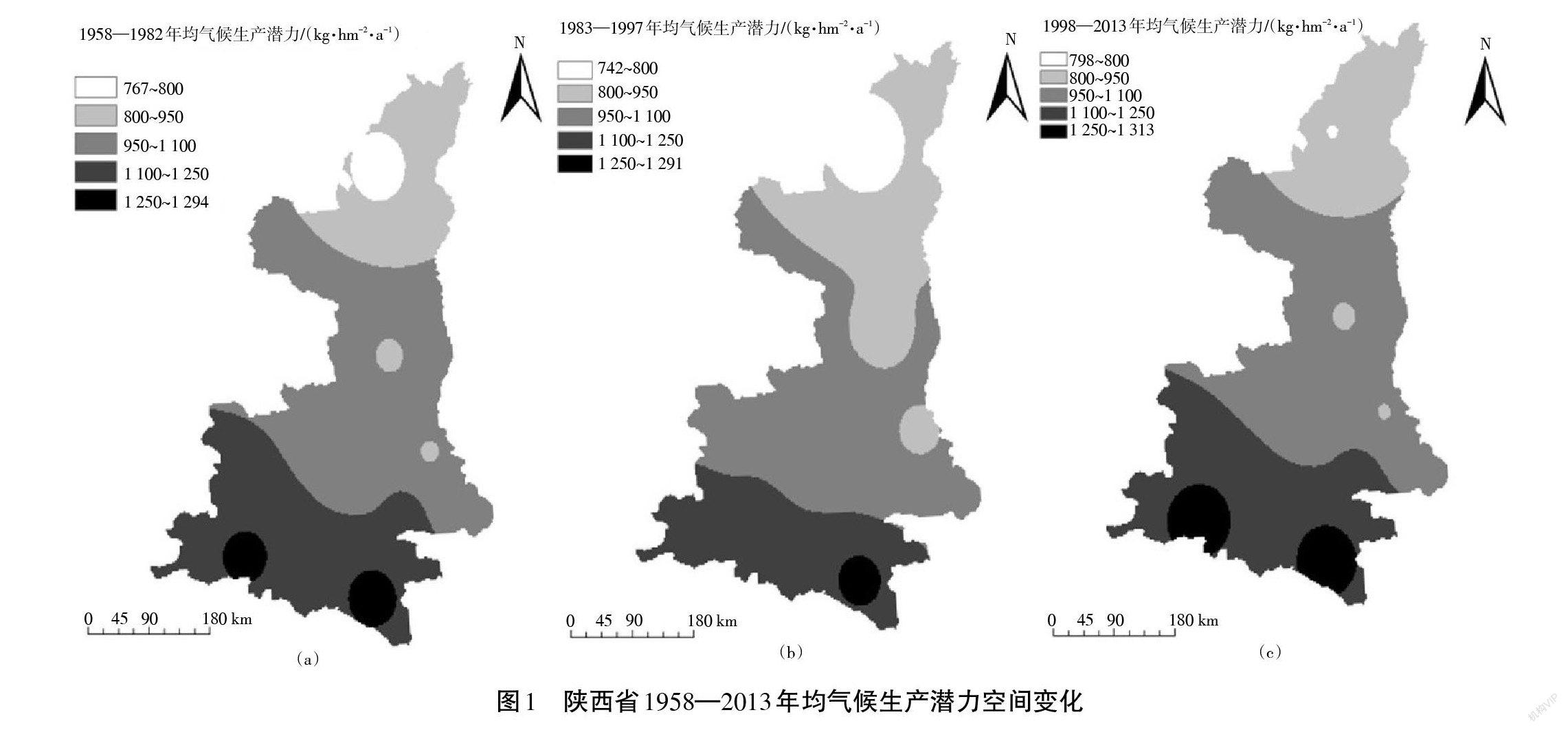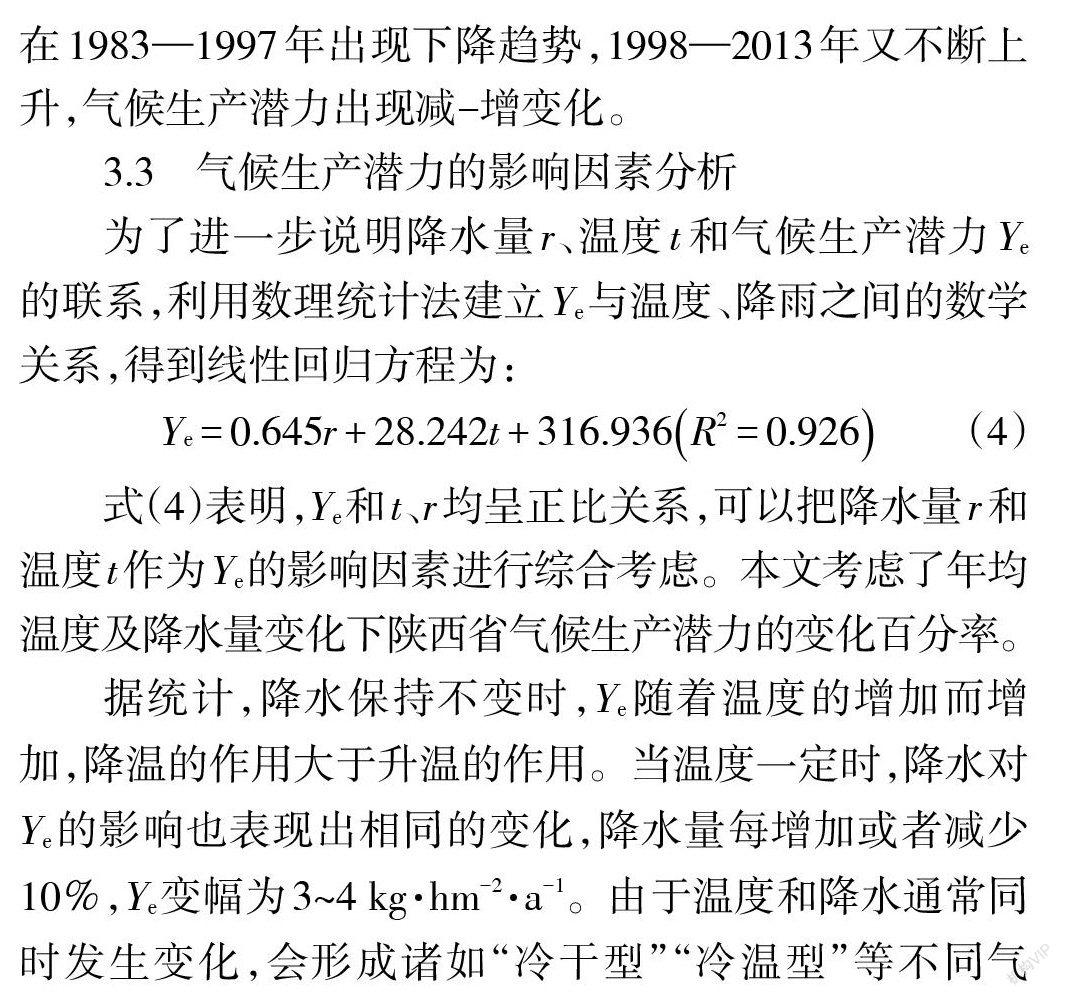1958—2013年陕西省气候生产潜力的时空变化
2021-09-26冯瑞
冯瑞



摘 要:为了对未来陕西地区农作物的区域分布、种植制度等方面提供科学依据,本文利用陕西省10个气象站台1958—2013年的降水和温度数据资料,利用Thornthwaite Memorial模型等方法研究陕西省气候生产潜力的时空变化。结果表明:①56年来,陕西省气候生产潜力微弱下降,具有南高北低的空间分布特征,总体由南至北递减。②气候生产潜力与温度的相关性不如降水显著,降水量的降低是限制气候生产力的主要因素。
关键词:陕西省;气候变化;Thornthwaite Memorial 模型;气候生产潜力
中图分类号:S162 文献标识码:A 文章编号:1003-5168(2021)24-0116-03
Temporal and Spatial Changes of Climate Production Potential in Shaanxi Province from 1958 to 2013
FENG Rui
(School of Earth Sciences and Resources, Changan University, Shaanxi Xi'an 710054)
Abstract:In order to provide a scientific basis for Shaanxi Province in the regional distribution and planting systems of crops in future, the precipitation and temperature data of 10 meteorological stations in Shaanxi Province from 1958 to 2013 were used in this paper. By the means of the Thornthwaite Memorial model and other ways to study the temporal and spatial changes of the climate potential productivity in Shaanxi Province. The results show that: ①The climate production potential of Shaanxi Province declined slightly in 56 years, with a spatial distribution characteristic of high in the south and low in the north, it is decreasing from south to south. ②The correlation between climate potential productivity and temperature is not as significant as precipitation, and the decrease in precipitation is the main factor limiting climate productivity.
Keywords: Shaanxi Province; climate change; Thornthwaite Memorial model; climate productivity potential
21世紀以来,气候变化的显著特征之一就是气候变暖,在全球气候变暖的大背景下,气候生产潜力成了气候变化所影响的一个方面。只有在明确气候生产潜力变化的基础上,才能够有针对性地制定有效措施保证粮食产量和安全。在气候变化对作物生产潜力的影响研究方面,20世纪80年代,德米季洛伊科[1]提出了有效降水量的概念,并建立了水分效应模型。樱谷哲夫[2]从生理角度论述了作物蒸散与其生产潜力的关系。王莺莺[3]等人运用全球生态区模型(GAEZ),分析了陕西省不同地理单元作物生产潜力变化趋势,找出了影响作物生产潜力的主要因素。赵放[4]等人运用EOF经验正交函数等方法,分析了旱作玉米降水利用效率潜力时空演变特征。
综上所述,如何挖掘生产潜力成为农业生产方面的一个重要课题,本文利用Thornthwaite Memorial模型计算陕西省气候生产潜力,研究了时空变化特征,分析了气候生产潜力与降水、温度之间的关系,对未来陕西地区农作物的区域分布、种植制度等方面提供科学依据,对陕西省作物生产潜力的研究具有深远意义。
1 研究区概况
陕西省位于中国西北部,地处107.4°~109.48°E,33.42°~34.45°N,全身地域狭长,地势南北高,从北到南可以分为陕北高原、关中平原、秦巴山地三个地貌区。陕西省是新亚欧大陆桥亚洲段和中国西北、西南、华北、华中之间的门户,具有承东启西、连接西部的区位之便。根据地形地貌特点,陕西分为陕北(榆林、延安),关中(西安、宝鸡、渭南、铜川、咸阳)以及陕南(商洛、安康、汉中)。
2 数据源及研究方法
2.1 数据源
根据陕西省的地理情况和地貌特征,选取10个站点,收集1958—2013年的相关气象资料,包括逐年平均温度、最高和最低温度、降水量等,资料来源于中国气象数据网(http://data.cma.cn)。地面气象资料站台选择原则是站台具有一定的代表性且均匀分布在研究区内,在保证有较长时间序列的基础上选取尽可能多的站点。
2.2 研究方法
Thornthwaite Memorial模型[5]依据蒸散量与温度、降水和作物之间的关系,计算气候生产潜力。公式为:
